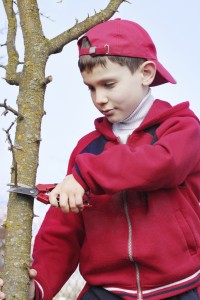 Now that March has arrived in the Chicago area, many Hartz homeowners (especially new homeowners) are anxious to get outside and start sprucing up their yards. But, a little restraint should be shown as the weather is still too unpredictable for full-blown landscaping and gardening activities. Having said that, here are five things you can do now that will pay off big once spring arrives.
Now that March has arrived in the Chicago area, many Hartz homeowners (especially new homeowners) are anxious to get outside and start sprucing up their yards. But, a little restraint should be shown as the weather is still too unpredictable for full-blown landscaping and gardening activities. Having said that, here are five things you can do now that will pay off big once spring arrives.
- Prune trees and shrubs. Prune away winter-killed branches to make room for new growth. Cut back to live stems by using a handsaw for anything larger than ½ inch in diameter. For smaller branches, it’s easier on your plants to use hand pruners, rather than electric shears. And, it’s okay to prune summer-flowering shrubs now, but wait to prune spring bloomers until after they flower.
- Cut back and divide perennials. Prune flowering perennials to a height of 4–5 inches and ornamental grasses to 2–3 inches to allow new growth to shoot up. Where soil has thawed, dig up perennials, such as daylilies and hostas, to thin crowded beds; divide them, leaving at least three stems per clump, and transplant them to fill in sparse areas. Cut back winter-damaged rose canes to 1 inch below the blackened area. On climbers, keep younger green canes and remove older woody ones; neaten them up by bending the canes horizontally and tipping the buds downward. Use jute twine or gentle Velcro fasteners to hold the canes in place. A pair of sharp bypass pruners makes a clean cut on both dead and living foliage.
- Clean up beds and borders. Rake out fallen leaves and dead foliage (which can smother plants and foster disease), and pull up spent annuals. Push heaved plants back into flower beds and borders, tamping them down around the base with your foot, or use a shovel to replant them. Now is a good time to spread a fertilizer tailored to existing plantings on the soil’s surface so that spring rains can carry it to the roots. Add a 5-10-10 fertilizer around bulbs as soon as they flower to maximize bloom time and feed next season’s growth. Use a square-head shovel to give beds a clean edge and keep turf grass from growing into them.
- Prep Damaged Lawn. Remove turf damaged by salt, plows, or disease to prepare for the seeding that should follow in a few weeks. As a rule of thumb, you can begin seeding once you see forsythia start blooming. Apply a pre-emergent weed killer now and get a jump on the weeds that may otherwise plague you for the rest of the season. It’s a good time to give your lawnmower and other lawn maintenance equipment a thorough inspection and possible tune-up.
- Tidy up stones and pavers. Rake escaped gravel back into aggregate walkways and patios, and order more gravel if needed. Refill joints between flagstones by sweeping in new sand or stone dust; water with a hose to set it, then repeat. If any pavers or stones have heaved over the winter, remove them and replenish the base material as needed before setting new ones back in place.
